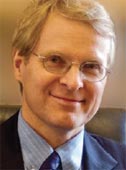Welcoming Syrian Migrants

Keith Jarvi
|
Semen is the underrated
biological fluid compared
to blood and urine. Keith
Jarvi, the Director of the
Murray Koffler Urologic
Wellness Centre and Head
of Urology at the Mount
Sinai Hospital, said: “in
our early studies, we had
focused primarily on infertility,
where production
and plumbing are the two
categories of efficiency. We have to biopsy to make a
diagnosis. We have looked at men with production
and plumbing problems for markers. We found three
that together are 98% sensitive and 100% specific.
The Koffler Foundation funded preliminary studies
that were promising. Once I had proof of principle, I
entered ‘the valley of death’ that precedes licensure (see also our previous article on Michael Tymianski). MaRS came through
with funding to get me across. We are now licensed in
China and the United States through MaRS Innovation.
Men are still getting biopsies in many jurisdictions, but
I am slowly putting my urology colleagues out of this
line of work.
“I am now working on refining prostate cancer markers.
Years ago, we started looking for markers of prostate
cancer. PSA, the commonest marker for prostate cancer,
was found in semen at 10,000 times higher concentration
than in blood. Prostate cells appear in semen. We
look for the cells, and proteins and we more recently are
looking at the DNA in the semen as markers for more
aggressive cancers. We can identify a better prostate cancer
marker, but we are 2 years from licensure. Testicular
cancer marker studies are in their infancy. We are looking
at DNA in semen. We consider ourselves world authorities
in the study of semen, the forgotten biological fluid.
We have 8,000 proteins in our database on semen and
seminal proteins. With our predictive studies, we will be
able to freeze sperm for young men before they eventually
become infertile from disease or treatment. This will
be important as testicular cancer is increasing in Europe
as is the rate of infertility.
“I started the prostate cancer markers studies by surveying
500 patients. 80% of men were willing to donate
samples. I am now working with Laurie Klotz, looking at
his repeat biopsy cohort in the Active Surveillance Study
(see previous Spotlight article). We have collaborators in
Montreal, Calgary, London, and 2 Toronto sites - PMH
and Sunnybrook. For the testicular cancer studies, we
have collaborators in Copenhagen and for fertility studies
in San Francisco, Cornell New York Hospital, McGill
and Calgary. Tony Finelli, Neil Fleshner, Laurie Klotz
send samples. We have 280 specimens from Calgary. It
all started with funding from the Koffler family. Now one
half of our Koffler Center is for research, and one half for
clinical work. We have regular meetings with epigenetics
expert, bioinformatics expert and mass spectrometry
expert. The physical proximity that brought us all together
in the Koffler Center has been highly productive. We have
grants from CIHR, Prostate Cancer Canada, industry and
MaRS Innovation. MARS came through when they saw
the commercial prospect. This is a great example of a basic
science/ clinician team concept. We have done over 1,000
patients - 350 of them prostate cancer patients. The goal
is to avoid needle biopsy in trying to identify high risk
prostate cancer, because 4% of cancer biopsies lead to
hospitalization.
|
“The technology now is amazing because of mass spectrometry.
Protein analysis that once took lots of time is
fast and massive now. The technology is racing ahead of
the clinical work. Eleftherios Diamandis is my alter ego,
a world authority on PSA. We have worked together for
7 years with 8 postdocs, 4 graduate students, 3 - 4 MSc
students, 10 summer students and numerous Centre
for Research in Environmental Microbiology (CREM)
students, 6 fellows and 4 residents, all funded by grants
from PSI, Prostate Cancer Canada, CCSRI, MaRS
Innovation, CIHR and various companies.
“A secondary goal is to build a male contraceptive - the
reciprocal of the fertility goal. We can knock fertility
out in mice. We do thousands of semen tests per year,
1,500 of them from Mount Sinai Hospital alone. We
hope to have a predictive marker for testicular cancer
10-20 years before it becomes clinically evident. The
male contraceptive study is an option. Our nanofluidics
engineer is Sinton. The IVF market in Canada performs
125,000cycles per year at $10,000 per cycle. We have a
$30 chip, which measures visco- elastic drag in Reynolds
units. A home test is in development as an IPhone app.
The University of Toronto is an amazing place to work,
with experts in everything. The engineers are keen to get
involved in these important biologic problems.
“My background was in math and I intended to become
a theoretical mathematician when I was a student at
Queen’s. I later decided I could be at the frontier in
medicine if I applied my math- computer background
to biological problems. I began with Mike Jewett at
Wellesley who took me into the lab measuring sperm
motility. I did time lapse cinematography, then went to
PMH computer experts to develop a digital analyzer.
After 6 months of work, I found that a computer analyzer
had already been invented, hit the market, and was
sweeping the world.
“I do 50% lab and 50% clinical work - largely on
infertility, including microsurgery for obstruction or
reconstruction of the vas deferens, microtesting, and
treatment of varicocele or undescended testicles.
“My wife Patricia Lee is an ObGyn doctor at Sunnybrook.
We have 3 children: our 18 year old son is studying computer
science at the University of Toronto and is planning
to study medicine. Our teenage highschool girls
are at Toronto French School. We enjoy biking, hiking,
skiing and other outdoor activities together as a family.”
M.M.
|